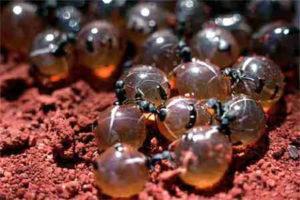Amazing honey ant: a barrel of nutrients
Among the huge variety of ants, a honey variety can be distinguished. The main difference of this species lies in the large amber belly, called the barrel, and the name is associated with the honeydew on which they feed.
Content
What does a honey ant look like: photo
Description of the honey ant
The color of the insect is very unusual. It looks like amber. A small head, whiskers, 3 pairs of paws contrast with a huge belly. The color of the belly colors the honey inside.
The elastic abdominal wall can expand to the size of a grape. The locals even called them earthen grapes or barrels.
Habitat
Honey ants are best suited to hot desert climates. Habitats - North America (western USA and Mexico), Australia, South Africa.
There is little water and food in the habitats. Ants unite in colonies. A family can have a different number of individuals. Each colony consists of workers, males and a queen.
Honey ant diet
Pests feed on honey or honeydew, which is secreted by aphids. Excess sugar comes out in the form of honeydew. The ants lick it off the leaves. They can also receive excretions directly from aphids. This is due to the stroking of the antennae.
Life
Large working individuals (plerergata) are engaged in providing food in case of a shortage of food. Nests are small chambers in which there are passages and one exit to the surface. Depth of vertical passages from 1 to 1,8 m.
This species does not have a ground dome - an anthill. At the entrance there is a small crater, similar to the top of a volcano. Plerergata do not tend to leave the nest. They seem to be suspended from the ceiling of the chamber. Paired claws help them to gain a foothold. Workers make up a fourth of the total. Foragers are called ants that hunt and gather food on the surface.
Trophallaxis is the process of regurgitating the food of foragers to plerergata. The blind process of the esophagus stores food. As a result, there is an increase in goiter, which pushes the rest of the organs. The belly becomes 5 times larger (within 6-12 mm). Plerergata resemble a bunch of grapes. The accumulation of nutrients makes the belly so huge.
In pleergates, the color of the belly may vary. The increased content of sugars makes it dark amber or amber, and a large amount of fats and proteins makes it milky. The belly is made transparent by sucrose obtained from the aphid honeydew. In some colonies, the pleergates are filled only with water. This helps to survive in arid regions.
The rest of the ants feed on pot-bellied sweet teeth. Honeydew is rich in glucose and fructose, which give strength and energy. The locals eat them instead of candy.
Mating of males and females occurs twice during the year. There is so much seminal fluid that it is enough to reproduce offspring for the rest of their lives. The uterus is able to lay 1500 eggs.
Conclusion
Honey ants can be called unique insects that can survive in very difficult conditions. The role of these insects is to save the colony from starvation. People also enjoy them as a delicacy.
Previous
